This article needs additional citations for verification .(August 2012) |

Wat Umong (complete name: Wat Umong Suan Puthatham) is a 700-year-old Buddhist temple in Chiang Mai, Thailand.
This article needs additional citations for verification .(August 2012) |

Wat Umong (complete name: Wat Umong Suan Puthatham) is a 700-year-old Buddhist temple in Chiang Mai, Thailand.
Wat Umong is located against the mountains of Doi Suthep and is about 1 km south of the main campus of Chiang Mai University. The wat occupies a tranquil setting and a small open zoo is stationed behind it. [1]
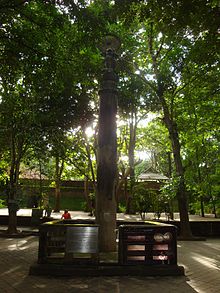
The temple was built in 1297 by King Mangrai of the Lan Na dynasty. [1]
Of particular interest is a modern replica of the original standing condition of the pillar of Ashoka at Sarnath in India. The Lion Capital of Ashoka survives in the Sarnath Museum, in an incomplete state, and at Indian independence was adopted as the National Emblem of India. It consists in four lions standing on an abacus, crowned by a large wheel called a Dharmachakra . [4]


The entire Wat Umong complex consists of 37.5 rai (15 acres) of wooded grounds. You can feed the fish, turtles, and ducks in a large pond. "Talking trees" have words of wisdom in Thai and English. The wat is famous for its ancient tunnels and large chedi. There are tunnels with Buddhist images below the chedi which can be easily explored. These tunnels were supposedly built by the King and painted with bush scenes so they could keep a famous but mentally deranged monk within the grounds of the monastery as he had a habit of just wandering off into the bush for days on end. Signs (proverbs) written in English and Thai hang from the trees on footpaths leading to the small lake where fish, pigeons, and turtles can be fed.
Other attractions include a Buddha field of broken sculpture, a fasting Bodhisattva, a Spiritual Theatre of paintings similar to those at Suan Mokkh, reproductions of ancient Buddhist sculpture of India, and a library-museum. This last building offers many books on Buddhism and other philosophies as well as a collection of historic objects and Buddhist art. [5]
Wat Umong is unique in that the resident monks live in a very natural setting, and occasionally feed the deer that live in the area. It also is possible to practice meditation at Wat Umong and to learn from the monks. [6]
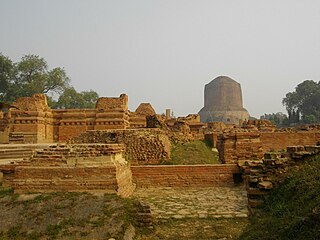
Sarnath is a town located 8 kilometres northeast of Varanasi, near the confluence of the Ganges and the Varuna rivers in Uttar Pradesh, India. According to the Lalitavistara sutra, the Gautama Buddha chose "Deer Park by the Hill of the Fallen Sages, outside of Varanasi" for the location of his first teachings of Buddhism, known as the Dhammacakkappavattana sutra, after he attained enlightenment at Bodh Gaya. It is one of eight most important pilgrimage sites for Buddhists, and has been nominated to become a UNESCO World Heritage Site.
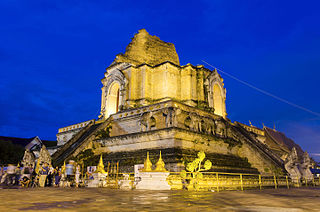
Wat Chedi Luang is a Buddhist temple in the historic centre of Chiang Mai, Thailand. The current temple grounds were originally made up of three temples — Wat Chedi Luang, Wat Ho Tham and Wat Sukmin.

The pillars of Ashoka are a series of monolithic columns dispersed throughout the Indian subcontinent, erected—or at least inscribed with edicts—by the 3rd Mauryan Emperor Ashoka the Great, who reigned from c. 268 to 232 BC. Ashoka used the expression Dhaṃma thaṃbhā, i.e. "pillars of the Dharma" to describe his own pillars. These pillars constitute important monuments of the architecture of India, most of them exhibiting the characteristic Mauryan polish. Twenty of the pillars erected by Ashoka still survive, including those with inscriptions of his edicts. Only a few with animal capitals survive of which seven complete specimens are known. Two pillars were relocated by Firuz Shah Tughlaq to Delhi. Several pillars were relocated later by Mughal Empire rulers, the animal capitals being removed. Averaging between 12 and 15 m in height, and weighing up to 50 tons each, the pillars were dragged, sometimes hundreds of miles, to where they were erected.

Wiang Kum Kam is an historic settlement and archaeological site along the Ping River, which was built by King Mangrai the Great as his capital before he moved it to Chiang Mai. It was flooded and abandoned more than 700 years ago; that move became more understandable in 2005, when the ancient city was flooded three separate times as the river overflowed its banks in that area of Chiang Mai.

The dharmachakra or wheel of dharma is a symbol used in the Dharmic religions. It has a widespread use in Buddhism. In Hinduism, the symbol is particularly used in places that underwent religious transformation. The symbol also finds its usage in modern India.

Wat Phra That Doi Suthep is a Theravada Buddhist temple (wat) in Chiang Mai Province, Thailand. The temple is often referred to as "Doi Suthep" although this is actually the name of the mountain where it is located. It is a sacred site to many Thai people. The temple is 15 kilometres (9.3 mi) from the city of Chiang Mai and situated at an elevation of 1,073 meters. From the temple, impressive views of downtown Chiang Mai can be seen.

A wat is a type of Buddhist and Hindu temple in Cambodia, Laos, East Shan State, Yunnan, the Southern Province of Sri Lanka, and Thailand.

Inthakhin is the name of the Lak Mueang of Chiang Mai. It is said that the pillar was first erected by King Mangrai at the founding of the city on April 12, 1296 CE at Wat Sadue Mueang on Inthawarorot road. It was brought to its present location inside a shrine on the temple grounds of Wat Chedi Luang by the Lanna king Kawila in 1800 CE.
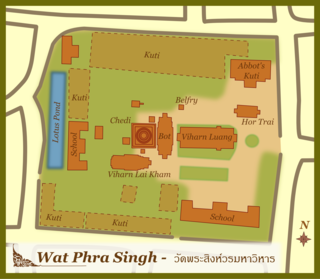
Wat Phra Singh is a Buddhist temple in Chiang Mai, northern Thailand. King Ananda Mahidol, bestowed upon it the status of Royal temple of the first grade in 1935.
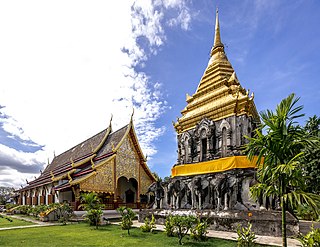
Wat Chiang Man is a Buddhist temple inside the old city of Chiang Mai, in northern Thailand.

Wat Lok Moli is a Buddhist temple in Chiang Mai, northern Thailand. The temple is situated on the north side of the north moat surrounding the old part of the city, about 400 meters west of the Chang Phuak city gate.

Bai sema are boundary stones which designate the sacred area for a phra ubosot within a Thai Buddhist temple (wat); otherwise called sema hin (เสมาหิน).
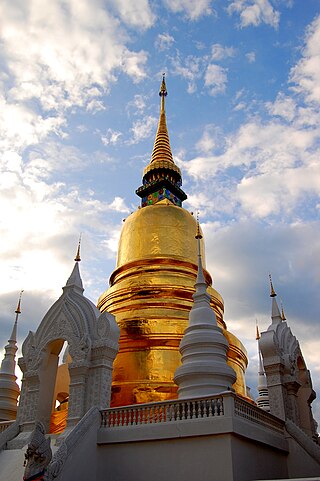
Wat Suan Dok, also known as Wat Buppharam is a Buddhist temple (Wat) in Chiang Mai, northern Thailand. It is a Royal Temple of the Third Class. The temple is on Suthep Road, approximately one kilometre west of Suan Dok gate at the west side of the moat.

Wat Pa Daeng is a Buddhist temple located in Chiang Mai, Thailand. Wat Pa Daeng historically served as the center for the Araññavasi forest-dwelling monks, who established a new sect at this monastery. The temple is near Wat Umong.

Wat Phan Tao is a Buddhist temple in Chiang Mai, northern Thailand. It is situated on Prapokklao Road, Mueang Chiang Mai district, in the centre of the old city.

Wat Umong Maha Thera Chan is a Buddhist temple in Chiang Mai, northern Thailand. It is situated on Ratchapakhinai Road in the centre of the old city.

Wat Rampoeng, also known as Wat Taoptharam, is a Buddhist temple in Chiang Mai, northern Thailand. It is situated in the area of Suthep subdistrict, Mueang Chiang Mai, on the outskirts of the city. The temple is well known for its meditation centre.

Wat Pa Pao is a Buddhist temple in Chiang Mai, northern Thailand. Situated at the north-east corner of the old city next to the moat, it was the first temple in Chiang Mai to be built for the Shan community.
On reaching the environs of Wat Umong, the excitement became more muted. The pillar was certainly a reproduction of the Sarnath Ashokan column, but (alas!) a modern reproduction of it. This could neither be dated to the 13th century, nor did it have any connection with a king of the Lanna line. The cement and concrete replica was set up some decades ago on the initiative of the Buddhist monastic community and its patrons at Wat Umong. They also got copies made of sundry sculpted panels from Buddhist sites in India.